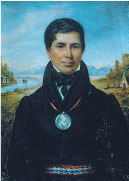During wartime, how do we relate to fellow Christians who stand on the other side of the divide?
War and international tension often create problems for the Church. How do we relate to fellow Christians who stand on the other side of the divide? How does Christian love relate to matters of conflict and national security?
American Methodists asked these questions more than 200 years ago as they looked across such a divide to the British lands that are now Canada. Their way of handling these questions helped shape the country we call home.
Since the 1790s America’s zealous Methodist Episcopal Church, always eager to win converts, had been sending saddlebag preachers into the wilderness of Upper Canada (a precursor to Ontario). Soon after, the same fiery evangelistic preaching could also be heard throughout Lower Canada as well (a precursor to today’s Quebec).
The preachers’ reception was not always warm, but they nevertheless earned a large following, especially in Upper Canada. Even Francis Asbury, father of American Methodism, went preaching through part of the province in 1811.
But in 1812 the Americans’ declaration of war on Britain threw the ministry into crisis.
Suddenly the American preachers belonged to the enemy and were, along with all other Americans, ordered to leave. Complying with this order would seriously harm the Methodist Episcopal Church’s ministry in Canada since its leadership would be entrusted to the small handful of preachers who were British subjects.
The Methodist Episcopal Church had a precedent for dealing with this kind of crisis. During the American Revolution Francis Asbury had continued to minister in the rebelling colonies even though he refused to swear allegiance to the Patriots. The American Methodists ended up taking a similar approach this time. The denomination would carry on its cross-border ministry to the extent that preachers volunteered and circumstances allowed.
Suddenly the American preachers belonged to the enemy and were ordered to leave.

PETER JONES AKA KAHKEWAQUONABY (1802–1856) HAD A CONVERSION EXPERIENCE AT A METHODIST EPISCOPAL EVENT. HE LATER BECAME AN OJIBWE CHIEF, SERVED AS A METHODIST MISSIONARY AND HELPED TRANSLATE THE BIBLE INTO OJIBWE. PAINTING: © VICTORIA UNIVERSITY LIBRARY (TORONTO)
Of course, these limitations were severe, but a few American preachers did end up serving Canadians – the enemy – during the war. One was Robert Hibbard, who not only stayed north of the border, but also decided to make up for vacancies outside his ministry area. The decision cost him his life – on his ministry travels he fell into a river and drowned. Another preacher ministered along the border with Vermont until the British military forced him back to the States. Ministry in Canada could be both dangerous and thankless.
On the American side of the border, Methodist preachers were not always as patriotic as their government would have liked. Minister William Case happened to be nearby when the British launched their attack on Sacket’s Harbor, New York, and he was more anxious for the souls of the soldiers on both sides than for his own safety or his country’s military success. When the firing subsided he hurried to the battlefield and sought to aid the wounded, both American and British.
After the war the Methodist Episcopal Church prudently relied heavily on British subjects to lead its ministry in the Canadas. They did, however, send a few Americans over the border, one of them being William Case. In 1823 he led a religious event where Peter Jones, later an Ojibwe chief and prominent Methodist minister, had a conversion experience.
Other Canadian-born Methodist leaders of this postwar era, who were heavily influenced by the older American preachers, pushed for political reform, but not revolution, and in so doing they helped shape the character of what would eventually become the nation of Canada.
The Canadian ministry eventually became independent from the American body, and throughout the century these churches effected a series of mergers with other Methodist groups and built a massive denomination that may have been the most influential of all the Protestant churches in the country.
By that point the days of the American saddlebag preachers were gone, but the preachers’ influence carried on in the pews and pulpits of churches across the country.
The example of the saddlebag preachers will not answer all our questions about relating to other believers in times of international conflict. However, we in the Canadian Church ought to remember our nation was shaped by people on the "wrong" side of the divide who resolved to serve not just people who loved and welcomed them, but also people who hated and feared them.

David Doherty is curate of St. Hilda’s Anglican Church (Anglican Network in Canada) in Oakville, Ont., and adjunct professor at Emmanuel Bible College in Kitchener, Ont. He drew many of these facts from 19th-century historians George Playter (The History of Methodism in Canada) and John Caroll (Case and His Contemporaries, vol. 1). Read more of these columns at FaithToday.ca/HistoryLesson.